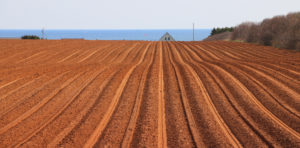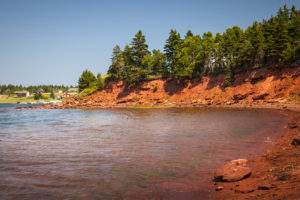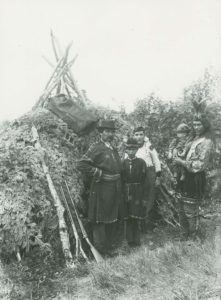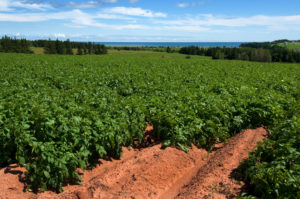Read the Following Selection
Read the following selection, or click on the play button below to listen aloud.
Prince Edward Island’s Bright Red Soil
Canada’s smallest province, Prince Edward Island, is famous for its red soil. What gives the earth that strong, bright colour?
Rusty Red

This shows Prince Edward Island’s red soil in a farm field

Red cliffs of Prince Edward Island’s Atlantic coast
Prince Edward Island is formed on sandstone, which is a mixture of sand and other substances. In the Island’s case, the sand is held together with lots of iron oxide, which is another word for rust. The rust adds a reddish tint to Prince Edward Island’s soil and turns the white sand beaches there pink.
An Indigenous Peoples Legend

Mi’kmaq group of the late nineteenth and early twentieth centuries
The Mi’kmaq (you say it MIG-maw) peoples who lived on Prince Edward Island told a story of how their home got its red soil. Long, long ago, the Great Spirit formed Mother Earth. But he found he was left with a large portion of dark red earth. What should he do with it, he wondered. The Great Spirit shaped the red clay into a crescent. Then he chose to form it into the most beautiful place on Mother Earth. This, he decided would be the home of his Mi’kmaq people. The Wise One named the island Minegoo, which means “The Island.” Next, the Great Spirit dressed the bright red island. He added green grass and thick forests. Then the Wise One sprinkled Minegoo with sweet, bright flowers. He decided to place the island in the Gulf of St. Lawrence, in the midst of the singing waters.
Perfect for Potatoes

Field of potatoes growing in the distinctive red soil of Prince Edward Island
Prince Edward Island is famous for its potato crops. Islanders have been growing potatoes since around the late 1700s. This vegetable grows so well here because of the island’s sandy soil. The soil holds just the right amount of water during the growing season. The iron and other metals and nutrients in the soil make it rich and good for growing vegetable crops. Almost the whole island is potential farming land. Add to this warm summers, cold winters and the right amount of rainfall and the Island has just the right conditions for potatoes. As well, the ocean around the island forms a natural barrier against diseases that travel through the air or are carried by insects. Today, Prince Edward Island is Canada’s largest supplier of potatoes.
Now, show what you know!
Complete some questions about the reading selection by clicking “Begin Questions” below.









